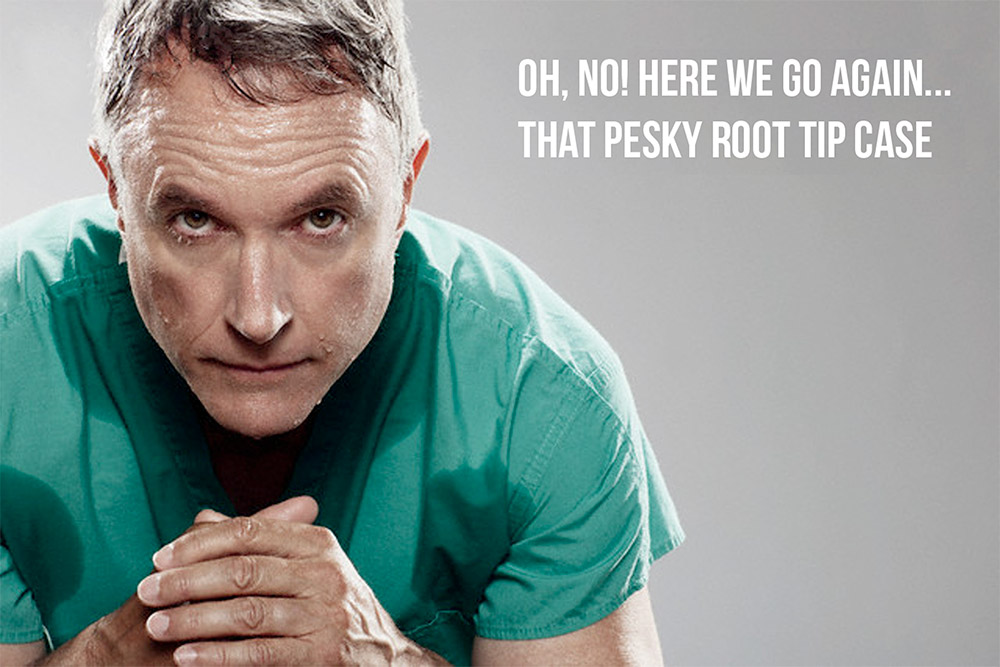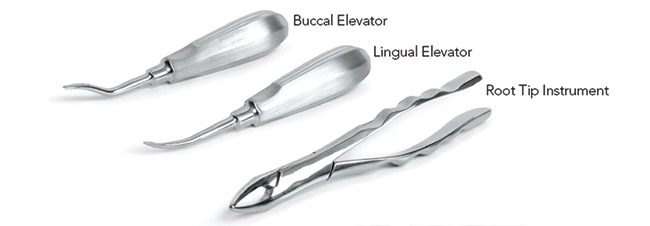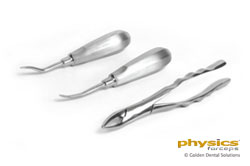Upper Root Tip Extraction System GMX 69

Stop Sweating it out!
Have you ever had an upper broken root tip that took you 40 minutes or more to get out, or did you have to refer this procedure out of your practice? Or worse yet, have you had a patient in the chair when you snapped the root and had to then refer this patient to another practice to retrieve the broken tip? With this system this should not happen in your practice. Extract upper root tips predictably and efficiently.

Upper Root Tip Extraction System - How it Works!
- First, the buccal, and then, the lingual elevators are placed between the gum and the bone and inserted at a depth that reaches the end of the root utilizing the guide lines on the elevators for assistance. It is very important to ensure the elevators reach the end of the root. The gum line should fall between the two guide lines on the elevators;
- Second, insert the instrument beaks where the elevators were placed in Step 1 (i.e., replace the elevators with the beaks of the forceps). The elevators are exact replicas of the beaks of the forceps. The beaks of the instrument should be inserted to the end of the root utilizing the beak guide lines to obtain proper depth; and
- Lastly, with wrist movement only and without squeezing, the bone is compressed to remove the root. As long as you do not squeeze you will not damage the bone. Specifically, with your wrist and no squeezing move in a buccal and lingual back and forth motion; move the beaks 1-2mm occlusally and again repeat the buccal and lingual movement until the root is completely compressed from the socket.

 As we have discussed before, we are strong believers that any tooth (except impacted third molars), in any condition, can be extracted simply, predictably and extremely efficiently by a general dentist if you are willing to think about exodontias in a different way than you have been taught through your formal education. Whether you graduated from dental school this year or forty years ago; the methods and instruments for performing and teaching exodontias have been relatively unchanged in over two hundred years.
As we have discussed before, we are strong believers that any tooth (except impacted third molars), in any condition, can be extracted simply, predictably and extremely efficiently by a general dentist if you are willing to think about exodontias in a different way than you have been taught through your formal education. Whether you graduated from dental school this year or forty years ago; the methods and instruments for performing and teaching exodontias have been relatively unchanged in over two hundred years.A perfect example is how we remove broken upper root tips or teeth that are below the gum line. Most general dentists would refer their patient to another practice or spend 40+ minutes trying to dig this root tip out. This is extremely stressful for the dentists, staff, patient and waiting patients. Dr. Richard Golden knew there had to be a better way for extracting upper root tips utilizing simple physics and leverage. Our Upper Root Tip Extraction System will allow you to atraumatically extract upper root tips in a matter of minutes while preserving the bone and not having to lay a surgical flap.
The GMX 69 is perfect when you cannot access the tooth with the Physics Forceps or other instruments. For example, when a tooth is severally decayed (mush) or when you cannot get a good purchase point on the tooth/root with the beak of the Physics Forceps, the GMX 69 is an invaluable instrument for this situation. With the GMX 69, you can extract the root atraumatically without performing surgery, removing bone, or laying a flap.
Have you ever had an upper broken root tip that took you 40+ minutes or more to get out, or did you have to refer this procedure out of your practice? Or worse yet, have you had a patient in the chair when you snapped the root and had to then refer this patient to another practice to retrieve the broken tip? With this system this should not happen in your practice.
Have you ever had an upper broken root tip that took you 40+ minutes or more to get out, or did you have to refer this procedure out of your practice? Or worse yet, have you had a patient in the chair when you snapped the root and had to then refer this patient to another practice to retrieve the broken tip? With this system this should not happen in your practice.
Conventional exodontias requires two equal forces applied on the tooth (squeezing) combined with a third force, which is the movement of your arm, to release the tooth from its socket. This is something we, as dentists, are all aware of and were taught in school. What we would like to focus on is what if instead, you did not squeeze the forcep, but simply used only wrist movement to compress the root from the socket. By compressing the socket with the GMX 69 forcep, the tooth will leverage its way down the socket until you can remove it.
The beaks of the GMX 69 forcep were designed and elongated to work more effectively. Depth lines were added to the beaks to gauge the approximate depth in which the forcep should be inserted. Two elevators (buccal and lingual) were designed to be exact replicas of the beaks of the forcep, which also have the same lines as the forcep beaks to assist with obtaining the proper depth. The elevators must be used prior to using the forcep in order to create the space for the beaks of the forcep.
- First, the buccal then lingual elevators are placed between the gum and the bone and inserted at a depth that reaches the end of the root utilizing the guidelines on the elevators for assistance. It is very important to ensure the elevators reach the end of the root. The gum line should fall between the two guide lines on the elevators;
- Second, insert the forcep beaks where the elevators were placed in Step 1 (i.e., replace the elevators with the beaks of the forceps). As noted earlier, the elevators are exact replicas of the beaks of the forceps, where Step 1 allows room for the beaks of the forceps to be inserted between the bone and the gum. The beaks of the forcep should be inserted to the end of the root utilizing the beak guide lines to obtain proper depth;
- Lastly, with wrist movement only and without squeezing, the bone is compressed to remove the root. As long as you do not squeeze you will not puncture the bone. Specifically, with your wrist and no squeezing move in a buccal and lingual back and forth motion; move the forcep beaks 1-2mm and again repeat the buccal and lingual movement until the root is completely compressed from the socket. If the root is not removed on the first attempt, repeat the forcep movement steps until the root appears and can be moved from the socket.
If you use the proper technique, you will not damage the bone at all. The bone is pliable and has memory. As you compress the bone by moving the forcep towards the buccal and lingual, the bone will return to its original shape due to the memory. This is why the system is atraumatic - literally there is no damage at all to the soft and hard tissues.
Some of the many advantages of utilizing this technique and the GMX 69 Upper Root Tip Extraction System include:
- Predictable and efficient root tip extractions typically in less than four to six minutes;
- Preserves the buccal bone and cortical plate;
- Prevents having to lay surgical flaps and removing bone to access roots;
- Increases services available to your patients so you do not need to refer them out;
- Increases patient referrals based on atraumatic tooth extraction; and
- Increases your bottom line by eliminating referrals.
We encourage you to learn more by watching this short video of Dr. Richard Golden discussing this system.
